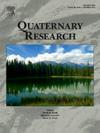Was there a nonglacial episode in the western Hudson Bay Lowland during Marine Isotope Stage 3?
IF 1.8
3区 地球科学
Q3 GEOGRAPHY, PHYSICAL
引用次数: 0
Abstract
Establishing the timing of glacial and nonglacial intervals in the core regions of the Laurentide Ice Sheet (LIS) is essential to constrain ice-sheet configuration at times of globally reduced ice volume, such as during Marine Isotope Stage (MIS) 3 (~57–29 ka). Hudson Bay Lowland (HBL) deglaciation, at the centre of the LIS, has been inferred at MIS 3 based on near-infinite wood radiocarbon ages and limited luminescence ages. To better constrain the age of the penultimate deglaciation of the western HBL, this study initially identified the youngest intertill nonglacial sediments, based on extensive fieldwork and till characterization. Next, vetted radiocarbon ages were combined with revised stratigraphy to show that five previously identified “MIS 3” sites were likely deposited during an earlier ice-free period. Finally, new optical ages targeting the youngest intertill nonglacial bed at three localities yielded ages ranging from 166 to 146 ka; all older than MIS 3. These ages indicate that the penultimate deglaciation of the western HBL likely occurred during MIS 5e. This interpretation better explains accompanying paleobotanic data sets that indicate vegetation similar to vegetation existing under present interglacial conditions. Currently no firm evidence exists in the terrestrial stratigraphic record for the deglaciation of the western HBL during MIS 3.在海洋同位素第三阶段,哈德逊湾西部低地是否存在非冰川事件?
在全球冰量减少的情况下,如在海洋同位素阶段(MIS)3(~57–29 ka),确定劳伦蒂德冰盖(LIS)核心区域的冰川和非冰川间隔的时间对于限制冰盖的配置至关重要。位于LIS中心的哈德逊湾低地(HBL)冰消作用是在MIS 3根据近乎无限的木材放射性碳年龄和有限的发光年龄推断出来的。为了更好地限制HBL西部倒数第二次冰川消退的年龄,本研究基于广泛的实地调查和直至特征,初步确定了最年轻的潮间带非冰川沉积物。接下来,将经过审查的放射性碳年龄与修订的地层学相结合,以表明之前确定的五个“MIS 3”遗址可能是在早期无冰时期沉积的。最后,针对三个地点最年轻的潮间带非冰川床的新光学年龄产生了166至146ka的年龄;都比MIS 3旧。这些年龄表明,西部HBL的倒数第二次冰川消退可能发生在MIS 5e期间。这种解释更好地解释了伴随而来的古植物学数据集,这些数据集表明植被与目前间冰期条件下存在的植被相似。目前,在MIS 3期间,HBL西部冰川消退的陆地地层记录中没有确凿的证据。
本文章由计算机程序翻译,如有差异,请以英文原文为准。
求助全文
约1分钟内获得全文
求助全文
来源期刊

Quaternary Research
地学-地球科学综合
CiteScore
4.70
自引率
8.70%
发文量
57
审稿时长
3 months
期刊介绍:
Quaternary Research is an international journal devoted to the advancement of the interdisciplinary understanding of the Quaternary Period. We aim to publish articles of broad interest with relevance to more than one discipline, and that constitute a significant new contribution to Quaternary science. The journal’s scope is global, building on its nearly 50-year history in advancing the understanding of earth and human history through interdisciplinary study of the last 2.6 million years.
 求助内容:
求助内容: 应助结果提醒方式:
应助结果提醒方式:


